Hoping to stimulate a little thought and discussion or at least attract one or two other opinions to engage with, I recently posted this on Facebook, along with the photo of the penny:
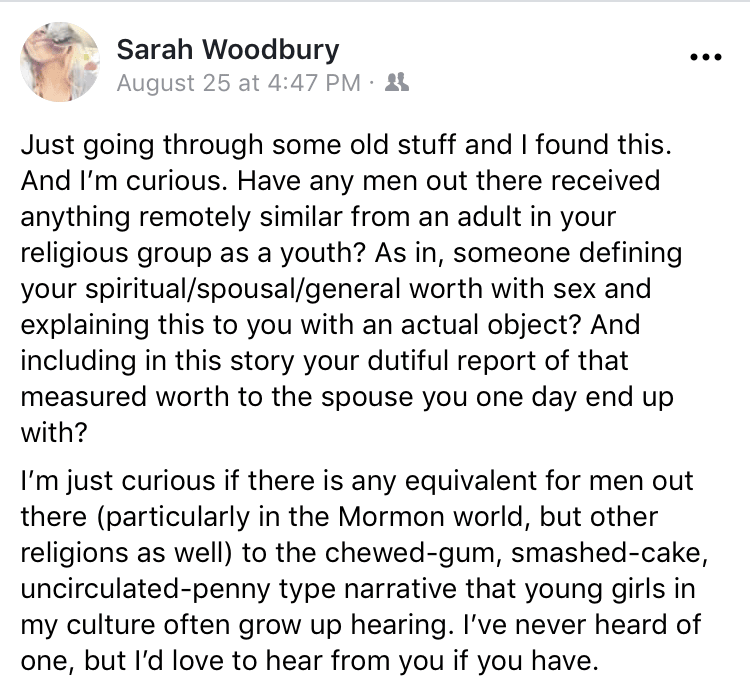

To my surprise, the post ended up gathering over 100 comments, creating an interesting dialogue and engaging a more diverse set of opinions than I expected. Because the post garnered a wide range of reactions, including interest, gratitude, fear, defensiveness, engagement, kindness, surprise, spiritual manipulation, open dialogue, personal stories, and criticism, I thought it would be worth it to write further explaining my position and diving a bit deeper into the topic.
I’m not sure exactly what my motives are, and I’m by no means a scholar on the topic. I don’t plan to convince people of anything, explain all aspects of the issues (they are vast), or try to make anyone angry. I simply feel compelled to write a bit more on my feelings about it, mostly as a further engagement with the people involved on the post. As a woman raised in the Church of Jesus Christ of Latter-Day Saints and in Salt Lake City, Utah (the headquarters of the church), I feel like it is very much appropriate for me to do so.
Before I start, I want you to know that I will not attempt to fully answer the questions raised or soothe the pain of the topic with an easy phrase—it’s just not me; and frankly, I find it tiring. I will go insane if I try. It’s just a slightly deeper look into a topic that I think is important to share because it concerns humans being deeply harmed.
I would suggest that if you choose to read it, you read to the end, because you will not get the overall picture unless you do. I also hope that you will read this with the intent to understand. On the original Facebook post, I tried to approach each comment with this kind of sincere intention, so I feel like it is fair of me to ask you to try not to read this with eyes searching only for why it is wrong.
A Bit More Background
For anyone who thinks this topic is not worth going into, or exists somewhere in the past and is therefore worth dismissing, let me share with you my discovery of the penny pictured as well as some other materials. I’ll also give you a bit of personal background to help you understand my perspective.
I was going through some old papers and journals when I came across a talk I wrote in high school. I’ve included it below:
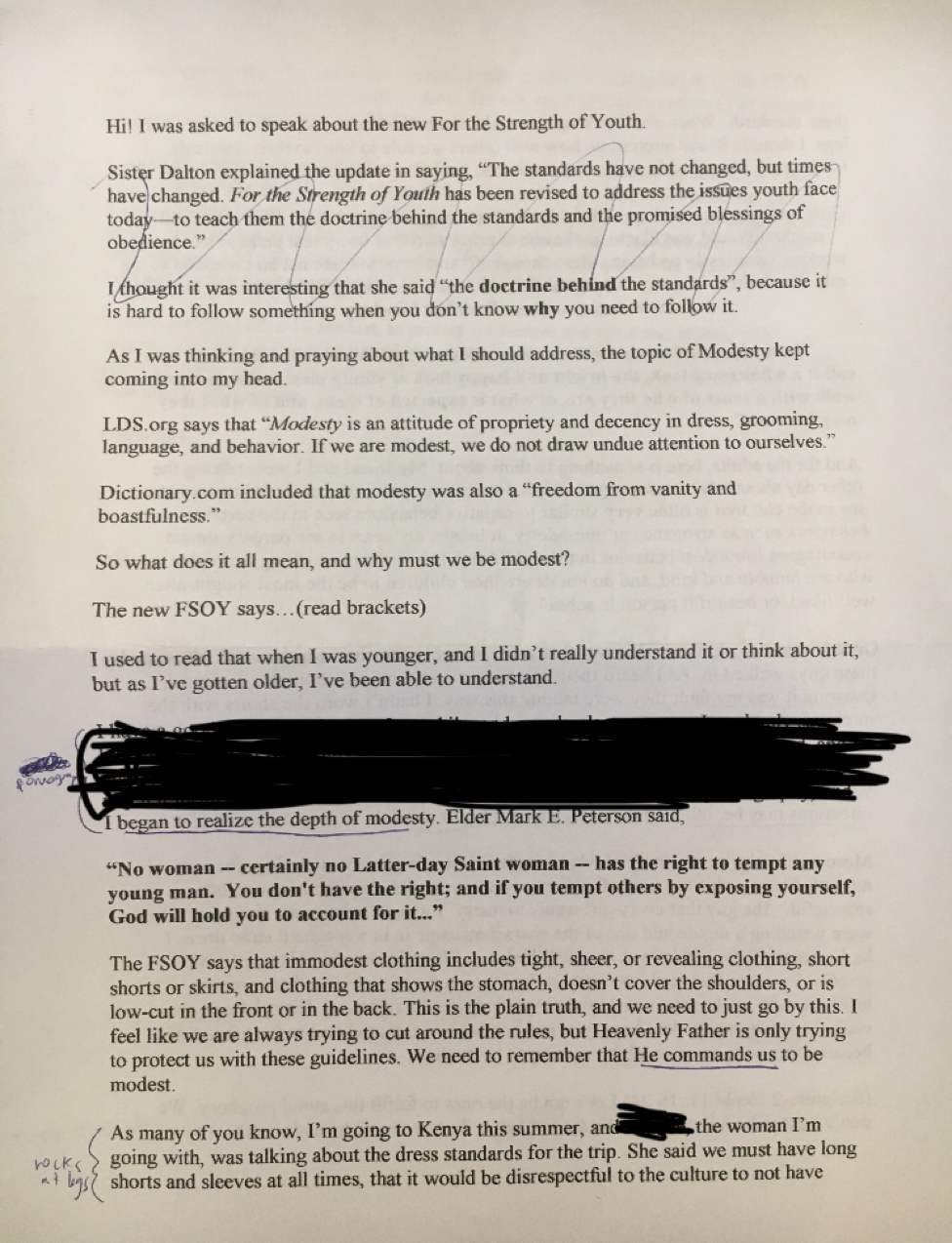
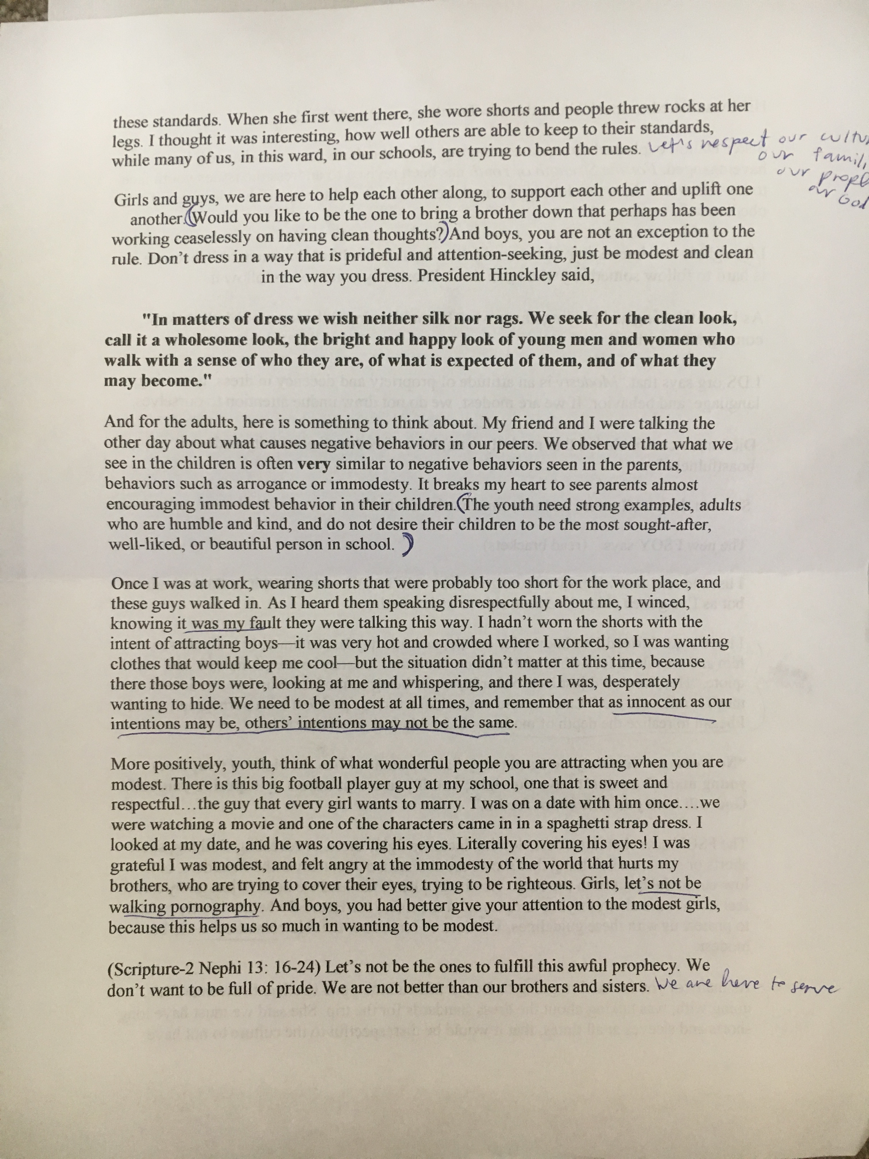
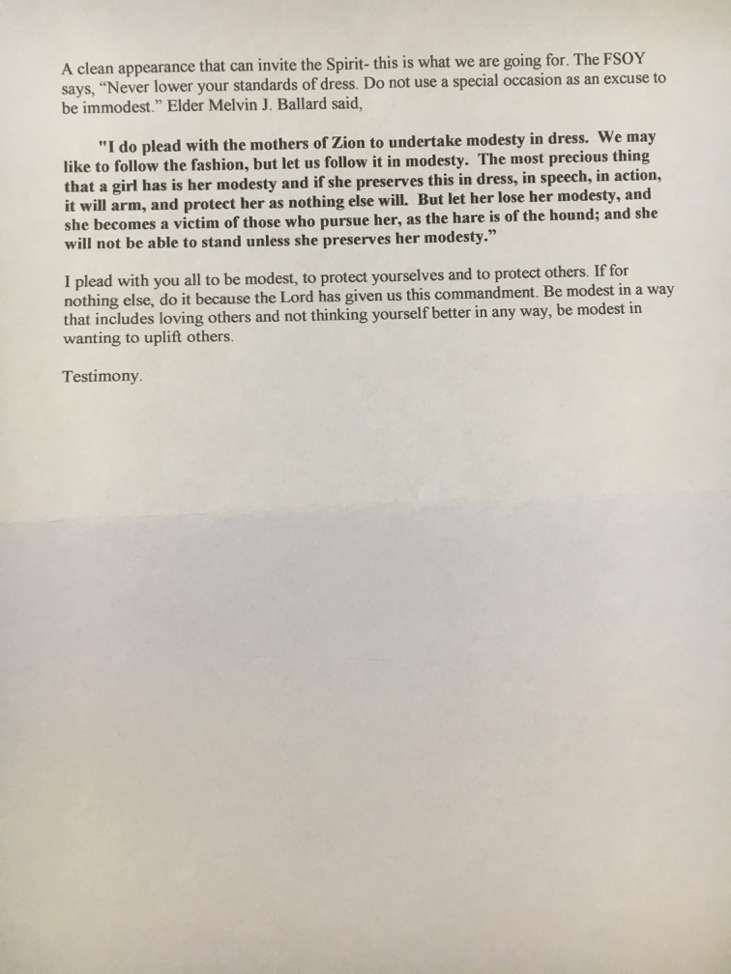
Seeing these kinds of words coming out of my own high-school-age mouth shocked me. I won’t go into why they are so insidious, but they were troubling to say the least.
I discovered the Uncirculated Penny just a few minutes before discovering the talk, and seeing these two objects together felt all too surreal. I was disappointed, frustrated, and frightened.
I’ve long been aware of the discussion on how terribly women are objectified when it comes to how Americans, and people in general, communicate sexuality. I’d heard of object lessons and been aware of why they’re not a great way to go. What’s interesting, though, is that I couldn’t remember actually having one of these lessons until I found the Uncirculated Penny — which I apparently found important enough to keep in my stash of meaningful quotes and talks.
Even if I couldn’t remember this specific lesson (or the other I have since recalled), I could remember my own painful experiences as a youth in the church trying to navigate church teachings on sexuality.
16-Year-Old Me
(Please don’t read this section if you are only reading to criticize. It is intended for those who want to understand. I know I cannot control what people will read, but I still respectfully ask you to approach it with kindness.)
I was a righteous young teen by church standards, refusing to kiss into the “passionate” realm or watch most movies with a rating worse than PG. I tried my best, and had I been a parent of me, I think I would have been proud.
But that couldn’t protect me from a boy, on my first date, doing something to my body that I did not want, anticipate, or agree to. I had told him before the date that I did not agree with “making out” or anything down that road, so I thought we were set. Apparently we were not set.
It was, comparatively, a small thing, and honestly, I would have likely been able to get over it relatively quickly—were it not for the culture I lived in.
I had read the For the Strength of Youth many times, and in the Chastity section read that if something sexual happened to you against your will, you could talk to your bishop and he would help you through it. Or something like that.
The freshly-dating, 16-year-old version of me couldn’t seem to figure out whether that meant I was required to go to the bishop to be officially forgiven for that unwanted experience, or if it was more of a suggestion to provide help. Nor could the 17-year-old version. Or the 18-year-old one. Or basically any one until the version that decided that I did not agree with telling a man sexual details about myself if I did not want to. Period.
That might seem small to you, but there is no way for me to describe the physical, emotional, and mental pain I went through for years following the incident.
No way for me to describe to you the pain of sitting in front of interviewer after interviewer, all of them middle-aged, gentle men, pretty sure I was pure enough to answer yes to the chastity section, but not positive. Smiling to hide the deep fear that I was not officially good enough. Wanting to bring it up to my parents but being afraid they’d want me to take it to the bishop. Burying the experience, small though it was, deep in my body and holding it there.
To be clear, I had a personal spiritual experience a year after that happened where I felt God told me, undeniably, that I was fine. It was beautiful and sacred. But for some reason, this was not enough to untangle me from the words banging around in my head that I had to tell my bishop.
That reality was not my fault. I had been taught that bishops were crucial to being forgiven of sexual sin, and I just could not separate this from my experience with assault.
Let me recap that experience for you:
- Girl gets assaulted
- Girl is hurt by that, but any human pain is quickly dominated by unnecessary religious fear
- Girl isn’t sure if she is supposed to tell a bishop for an official spiritual pardon
- Girl cannot talk to any adult about it for fear she’ll have to go through a confession process or be thought of differently
- Girl feels she is told directly by God that she is okay
- Girl still feels unworthy
- Girl spends years of her life replaying that one incident almost every day
- Girl cannot get over it until she renounces the confession idea at large
Whatever your thoughts on church interviews, feminism, the repentance process, etc., this thing I went through—and that thousands of girls go through in degrees much worse than mine—is wrong.
So you can imagine my wincing when I found the penny, and when I read my own words scolding my young self (and all girls in the audience) for wearing shorts that were too short, repeating the idea that women are responsible for men’s actions.
There was no sugarcoating it, speaking in parables, or anything else: I thought that I was responsible for the men I overheard objectifying me at work; that because I was born a woman, I would become “walking pornography” if I did not cover enough skin; that it was up to me and all women to carry the violence of all men not only in our bodies, but in our spirits too.
One thing I find interesting is that no adult in the audience corrected me or tried to talk to me about the topic. I shared the following quotes over the pulpit, yet there was no alarm raised that I was aware of (keep in mind that recently, a young girl who talked about being a lesbian in Sacrament Meeting had her microphone cut and was asked to sit down):
1. “No woman – certainly no Latter-day Saint woman – has the right to tempt any young man. You don’t have the right; and if you tempt others by exposing yourself, God will hold you to account for it.”
2. “The most precious thing that a girl has is her modesty and if she preserves this in dress, in speech, in action, it will arm, [sic] and protect her as nothing else will. But let her lose her modesty, and she becomes a victim of those who pursue her, as the hare is of the hound; and she will not be able to stand unless she preserves her modesty.”
So here I was, somewhat tortured because of the system, yet wholeheartedly absorbing and spreading some underlying ideas that cause this kind of pain, including:
- A woman’s worth is tied to sex and “purity,”
- her highest possession is her sexual abstinence, and
- she is responsible for men’s actions.
I didn’t mean to, but I was a part of a shame and fear-based conversation — the kind of conversation that creates (and is created by) teachings like the object lesson.
The Innate Problem of the Object Lesson
Object lessons cannot meaningfully communicate sexuality, so I do not think they should not be used to communicate ideas about sex.
If, for example, you teach a girl that sexual activity will result in her being like a chewed piece of gum, you are suggesting that:
- Her worth is in her “unchewedness,”
- such a vast part of human experience can be boiled down to a silly image, and
- it is okay to use sexual activity as a measure of whether a woman is a desirable or worthy partner.
These things are unhealthy for anyone to internalize.
Some other chastity-related object lessons I’ve heard or read about, whether from official materials or other church members, include:
- The penny one (firsthand experience)
- Unwrapping Starbursts and relating the temptation to eat it to the temptation men face when women wear less covering clothing (firsthand experience)
- A smashed cake representing a person who has “lost their virtue” and is not desirable
- A beautiful fence that has nails hammered into it. The idea is that even if the nails are removed, the holes never can be (does anyone else absolutely cringe at this one?)
- Chewed gum, with symbolism similar to the smashed cake narrative (gum cannot be “unchewed”)
- M&Ms being passed around in various degrees of being open, as a simile again to the temptations caused by immodesty
- Old, beat-up hangers vs. new hangers, with the question of which hanger you’d like to hang your beautiful new dress on – in this scenario, the sexually ruined girl is like the beat-up hanger and the sexually pure girl is like the new hanger
- A girl going to get a piece of bacon from a smokehouse, able to get out, but never able to get the smell out of her dress
These all involve equating girls (or boys, occasionally) to literal objects. It involves fear and manipulation being used to control what young people do.
I feel like this is a continuation of and contributor to the patriarchal and sexually sick society we live in, which has been objectifying women and using fear to control their sexual experience for thousands of years. Not okay.
The Impact on Survivors of Abuse
Some have said to me that rape/abuse are a different topic than how to communicate sexuality, but I wholeheartedly disagree.
Many of you will have heard about the experience of Elizabeth Smart, a Mormon girl who was kidnapped as a child, spending horrendous months in captivity before being rescued.
In an LDS Living article, she gives us some insight on the impact of object lessons on girls:
“I think the power of faith is amazing, the hope and the healing that it can bring to people…”
“But I also think there’s another side of it that can be potentially very harmful, especially when a lot of religions teach that sexual relations are meant for marriage… It’s so stressed that, girls in particular, tie their worth to their virginity, or, for lack of a better word, purity…”
“I did make that promise to myself that I was going to wait until marriage before I had sex… Well, then I was kidnapped and I was raped, and one of the first thoughts I had was, ‘No one is ever going to want to marry me now: I’m worthless, I’m filthy, I’m dirty.’ I think every rape survivor feels those same feelings, but having that with the pressure of faith compounded on top—it was almost crippling.”
The same article says:
“Even after her rescue, Smart sat through another such lesson, in which she was told: ‘You’re like this beautiful fence, and you hammer these nails in, and then every time f have sex with someone else, it’s like you’re hammering in another nail. And you can take them out, you can repent of them, but the holes are still there.’”
And an article from Broadly ventures further into object lesson territory in relation to Smart, saying:
“[Smart] often shares, as an example of what not to teach young girls, an analogy that she learned as a young child in Sunday school: ‘You’re like this stick of gum, and if you have sex before you’re married, it’s like someone chews up that piece of gum, and then when you’re done, who wants a piece of gum that’s already chewed up? No one.’ That was the first thing she thought of after Mitchell raped her on the night of her kidnapping.”
There really isn’t anything to add to that. Teaching chastity in this way is cruel to all who have been sexually assaulted or abused.
Additionally, as was pointed out to me by one of my favorite schoolteachers, 1 in 4 children in Utah are sexually abused or assaulted. We wish this weren’t true, but it is. I think we should teach in a way that deeply meets the reality of abuse, rather than adding it as a side note at the end of an otherwise insensitive lesson.
Separating Sex from Assault
One issue important to this topic is the inability of our society to understand that rape, abuse, or assault are not the same as sex, but are, rather, forms of violence that are inflicted with the weapon of sex.
The struggle to separate sex and assault is highlighted by the fact that when a woman is raped in the US, she is often asked by officers, family, the community, etc. what she was wearing.
Clothing choices are completely unrelated to crimes—what a person is wearing cannot be equated to an invitation for sexual acts. If someone is robbed and beaten, we do not ask them why they were carrying a bag. Violence is violence, and it can be inflicted with thousands of weapons, including sex.
To put it simply, to do something sexual to anyone, you need their permission, and this permission should be eager rather than coerced. If you do not have enthusiastic consent, you are violating their body and your act becomes violent rather than sexual.
But I’m going on a bit of a rant. What I am trying to say is that if people cannot separate sex and violence in society at large, how can we expect children to do so in their own experience?
If a child is taught that sexual purity=their worth, can we realistically expect them to understand that assault is separate from this idea? I would obviously answer no from my experience, observation, and research, but any child psychologists out there are free to weigh in.
Women: (Sole) Guardians of Virtue
As is made obvious by my post, I do not agree with object lessons being used to communicate chastity. I think many of us can agree that this way of teaching implicitly objectifies the students and therefore communicates harmful ideas.
But beyond this, we often teach ideas that are less-obviously damaging. A few examples include teachings that women are “guardians of virtue,” that we hold sexual power over men, or that our “natural heightened spiritual purity” gives us more responsibility than men when it comes to sexual activity.
These kinds of ideas might be communicated, for example, through telling a girl that she must be modest to help keep the boys’ thoughts pure. I have never heard the reverse of this idea taught.
Narratives like this are not unlike other sexist stories that have been told throughout the ages, such as sirens seducing and destroying fishermen or Eve being responsible for the Fall of Man.
Consider the artistic depictions below.
In the following painting, we see the story of Odysseus, who asks his men to tie him up so he will not give into the seductive calls of the sirens, who are depicted in their traditional form, as part bird, part woman.

In the next image, you see a depiction of Eve convincing Adam to partake of the fruit. In much of Christianity, Eve’s causing the Fall is used to paint all women in a negative light or justify their place as second-class citizens.
Notice that the serpent, symbolic of Satan, is depicted here with the head of a woman who appears to be Eve.
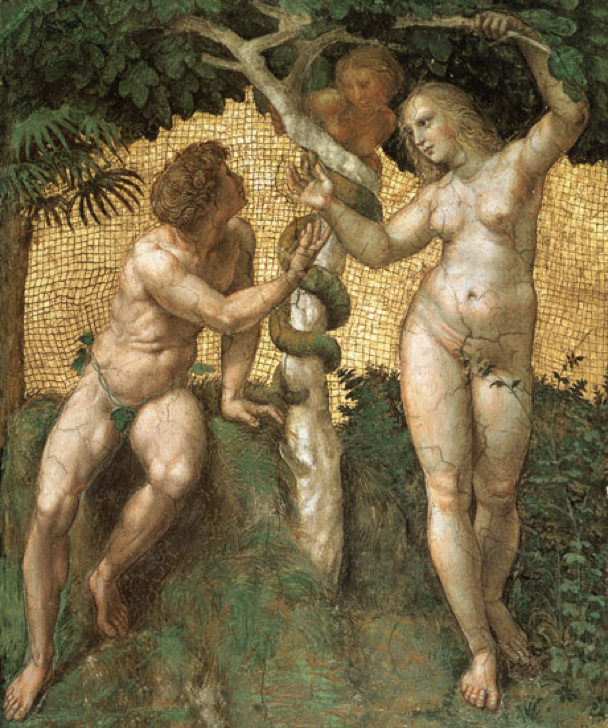
The next piece is also a depiction of the story of the sirens and Ulysses. This is one of the first times that sirens were painted not in their traditional form, as half-bird, half-woman, but as just…women. Wingless, seductive, nude-body-flailing women. Notice the male carnage surrounding the naked bodies of the sirens.

My point is that commonplace ideas communicated to girls and women about sex are not new. They are, rather, embedded in our stories, religious texts, and histories.
Though present norms are a result of a patriarchy extending deep into our past, I think some of humanity is starting to wake up. We can see these types of narratives for what they are and work to weed them from our present reality.
In Response to Common Replies
Many replies to my post came to the defense of the church and its leaders, saying that these kinds of teachings are examples of how people are imperfect despite being a part of a perfect church. There were also comments that claimed that these kinds of teachings were not started by church leaders and were not found in manuals or other official materials.
To me, this type of narrative is problematic because it:
- does not give enough credit to the individual members of the church,
- chooses to ignore, overlook, create, or simplify facts, and
- is an example of giving an easy answer instead of critical thought to a serious issue.
Let me briefly explore each of these by quoting the general way they were phrased to me. These kinds of comments were repeated by wonderful people, and I in no way mean to shame or attack any individual. These are just my thoughts.
“It’s the Teachers, Not the Church”
Multiple people have expressed to me that object lessons are inventions by individual teachers who are trying to communicate tough ideas, and therefore, the church has no responsibility for the teachings.
I agree that teachers, on their own, often communicate sexuality in ways that either are wrong or accidentally hurt the students. That’s something parents, school teachers, and Sunday School teachers should all be aware of and working to change.
What I cannot stand behind, however, is the notion that the LDS church is excused from this problem because of these human imperfections.
In my opinion, teachers are teaching within a system, and this system encourages certain norms and cultures which become virtually inseparable from the church itself. If thousands of teachers, most of them wonderful people, are using the exact same narratives and ways of teaching, something deeper is going on.
Such a mass norm existing within in a culture should be cause to question the governing beliefs and ideals of that culture, not an invitation to shame individuals for their total misunderstanding of how to teach.
I do not relate to the feeling that we must defend the church at all costs, throwing the people and teachers that stand in our way under the bus if something negative is pointed out. To me, it is troubling to think that we can set empathy for individuals aside in order to keep the church or its leaders in a perfection state.
The empathy that gets set aside is not only that for the teachers, but also for the thousands of children and adults who have been impacted by this kind of culture.
“This Is a Problem, But it Doesn’t Come from Official Materials or Leadership”
As I have pointed out, I feel it is not logical to say that deeply flawed, harmful teachings spring up out of nowhere. They are, rather, taught within the context of a larger cultural stage.
But it’s not just a general culture I’m talking about. The notion that these ways of teaching have no base in “official” materials or words is incorrect. I can point to numerous official manual materials and their included object lessons and stories, Conference talks, prophetic quotes, scriptures, etc. that will help us understand that these exact stories/sentiments are very deeply present in the official arena of the church.
One such story is this, which was in a Young Women’s teaching manual that was in use until 1992 (quoted from Janine Boyce’s article because, as far as I know, the manual is not online):
“The lesson includes a story about a young girl who begins dating an attractive LDS young man named Rod. The girl soon begins to suspect that Rod has a drinking problem, but she rationalizes her fears and decides she can help him overcome this addiction. One night the girl attends a party with Rod where he begins drinking. That night when he takes her home, the story continues: ”After a few kisses he began to overpower me in a very intimate way. I did not have the strength to control him. Somehow I was able to jump from the car…. As I ran home, my clothes were torn, I sobbed uncontrollably, and my body shook all over. I realized that the first lie to myself was Satan’s invitation to take over as the Holy Spirit departed from me. I almost lost my virtue that night with Rod, and now I know it all began with a lie to myself.”
Within this simple story, the following ideas are communicated:
- Virtue is something that can be taken forcibly from a girl
- A girl can be at fault, in any way, for a boy’s violation of her body
- The Spirit will protect you from being raped/assaulted (as long as you’re paying attention)
- Girls should learn how to better “behave” themselves if they are assaulted
These are frightening ideas that feed into a rape culture, meaning a patriarchal culture that ultimately blames a woman for what men do to her. I don’t feel like I need to explain why this is problematic.
The point is that these stories and sexist ways of teaching, whether or not we want to believe it, are present in official materials and talks. I understand the desire to say that these kinds of things surely must not have been officially directed. It’s hard to reconcile that with belief in a divinely-directed truth.
However, these stories do come from leaders and official materials. They just do. So let’s move past this response.
“The Church Is Perfect, But the People Aren’t” – Easy Answers
I don’t think I’m alone when I say that I do not feel heard when my thoughts and questions are met with words that feel like they’re poured from a mold. Sayings like “the church is perfect but the people aren’t” do more harm than good, in my opinion.
The church just does not have a perfect track record. I don’t know of any other way to say this. But as I write it, I know that hinting at imperfections will frighten some members or give rise to immediate defensiveness. I sincerely wonder: Why is this? Why must the teachers be the scapegoats in this situation, with leaders/official words saved only through the willing sacrifice of the members?
I get it, I really do. If the church is 100% true, then its release of teachings, doctrines, or talks that are harmful (=not true) is hard to reconcile. And because the church claims direct leadership by God, we are, it would seem, presented with a simple binary that it is either true or it is not. To me, this explains why a problem pointed out within the church might feel to members like it threatens the truth of the entire organization.
But I do wonder, sincerely, whether we can move beyond that point and decide that issues with church teachings, history, or norms do not necessarily have to bring the whole organization down. Or is this simply not possible with a church that claims direct, divine leadership? Even if there are things in the church that do not hold up morally, can there still be truths within it? Or is this a situation where it must either be entirely true and led by God or…not?
I’m not sure.
But let’s move on.
But What About the Lesson Disclaimers?
When these kinds of lessons are taught, they may indeed include a mention of the Atonement or the fact that survivors of abuse are not the same as those who choose to be sexually active.
I would certainly hope that any lesson involving chastity includes mention of the Atonement, the unbounded love of God and Christ, and the reality of abuse and assault.
However, I don’t think that including these topics make the object lessons as a whole acceptable. Because if you teach people that their worth is tied to their sexual actions, you will plant some deep, unforgiving seeds, whether or not you stipulate that abuse victims “don’t count.”
All beings have deep, innate, eternal worth, no matter what they do or experience. And making our children feel like any of that is diminished by their sexual actions is extremely frightening.
How do you untangle that kind of teaching at marriage, or in the event that a child experiences something sexual (part of growing up)? I don’t know if you fully can. I think sexuality can and should be taught in a more realistic, loving, understanding way.
What I’m NOT Saying
- Teach Kids to Be Sexually Active! – I’m not saying that I think that kids can never be taught by loving parents to wait until marriage to be sexually active. Parents have the right to do this. I don’t think, however, that anyone has the right to use manipulation or fear (by using object or worth-based ways of teaching) to get others to obey them.
- The Church Is the Only Group to Blame – I’m also not saying that the church is to blame for rape culture at large. No. The church was founded and has come of age in America, which has some serious problems with objectifying and sexualizing women’s bodies. And this happens in every arena. Media. Schools. Advertising. Belief systems. It is everywhere. I am only saying that the church is not separate from this reality, and I do not feel a need to try to pretend that issues in sexuality communications do not exist. If the church is led through divine revelation, I think it should do better to rise above these harmful norms.
- The Church Must Not Be True – And I’m not saying that problems in the church must mean that the church is not true and the entire organization must now be denounced. Nope. If you feel like that is the point of this blog post, I think we could have an interesting conversation about why that is.
Beautiful Realities We Can Use to Move Forward
I am also not saying that the church, in all ways, teaches sexuality in flawed ways. I happen to personally think that how sexuality is currently taught can be harmful, but I certainly do not think it is all bad.
For example, the Atonement has helped me through a great deal. I am beyond grateful for that teaching.
Additionally, the teaching that sexual intimacy is beautiful and sacred is something I very much agree with. I don’t like all the sensational ways it is depicted around us. It’s a normal part of life, a way to connect couples, and something I don’t think should be exploited the way it is now. (I do feel like keeping bodies and sex so secretive, as Christianity likes to do, adds to the sensationalizing and exploitation of sex, but that’s another conversation.)
I won’t keep going, but I wanted to include that thought for those who I’ve spoken with that are saddened to hear negative things said about the church. I feel like exploring harmful realities does not necessitate the immediate qualifying of your opinion or the listing of many positive things, but I do understand how personal it can feel when someone points out an unsavory aspect of something that is a part of everything you do.
Let me say it again: I am not saying that these issues mean that the church, at large, is a terrible organization. I only think that we should think critically about reality rather than trying to hide or avoid it — and then work to change it. The well-being of humans is what we’re looking at here.
The Bottom Line
If you read only one thing from the original post or these words, I hope you read the part about assault or the comments from people talking about sexual abuse and assault and how these teachings impacted their lives. These voices must be heard. They are absolutely central to the discussion.
I also hope you can see that I am just trying to talk about something that has harmed many people, particularly women. This is not a message coming from hatred or a desire to argue; it comes from personal pain and concern for other human beings who will have their lives deeply affected by systematic errors—which can be changed!
Someone who engaged with the post wanted more of a focus on solutions. But I don’t offer solutions here because that isn’t the point of the post. I feel like the conversation, which is only just beginning, is vital to have and is a starting point for solutions. I just wanted to describe my feelings in one place. Plus, I am not a parent, psychologist, etc., so I don’t feel like I really have a whole lot of experience there.
If you want some words from me on solutions, though, I’d say: Let’s stop objectifying girls and teaching children that their worth is tied to their sexual experience. We should teach everyone that their worth and the worth of others is innate and unconditional. Teach them a deep sense of true confidence in who they are, leaving their looks, bodies, marital status, sexual experience, relationship to others, etc. out of the worth-measuring stick.
But I don’t really know enough to expound.
I do know that there is a problem, and one that is hurting a lot of good people. It can influence relationships, confidence, healing, and nearly every aspect of life. And for those concerned about the status of the church being threatened by suggestions like these, my approach would be to try to fix the problems instead of hiding or explaining them away. There is so much positive change that can be made.
I’d love to hear your thoughts, but I do ask that you don’t try to call me to repentance or make personal attacks. It won’t help anything. If you are tempted to do so, I would encourage you to sit back and let things soak, like I tried to do with comments I disagreed with, before replying. And if you cannot reply without being cruel, write those words in your journal instead.
I have found that this topic is extremely sensitive to people, so please know that I did not write it with the intention of personally offending anyone. I hope that if you do comment, it can be a safe, kind place where we all learn from and respect each other’s unique perspectives, experiences, and opinions.
© 2018 Sarah Ann Woodbury
Love you sarah.
LikeLiked by 1 person
Aw, thank you so much Kim. I love you.
LikeLike